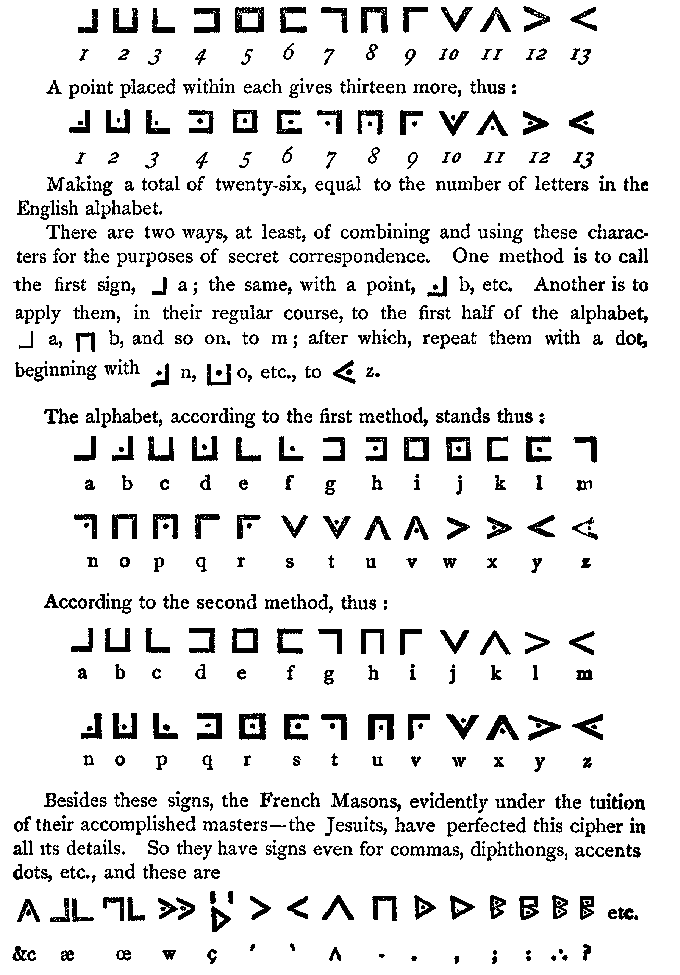A forgotten Number Notation of The Middle Ages
The Cisternian Cipher
David A King:
This forgotten number-notation was developed in the late 13th century by Cistercian monks in what is now the border region between France and Belgium. It was used by the Cistercians - admittedly by only a few but nevertheless all over Europe - for at least two centuries thereafter, as an alternative to the well-known Roman numerals and the less-well-known, new Hindu-Arabic numerals. The monks used it for numbering pages of manuscripts and items in lists, for writing for representing year-numbers in dates, and for numbering staves of music. The two dozen surviving manuscripts featuring ciphers are from localities between England and Normandy to Italy and between Spain and Sweden.
This numerical notation was also used outside the scriptoria of the monasteries, for we find it used on a remarkable mediaeval astronomical instrument - an astrolabe, that is, a two-dimensional model of the universe that one can hold in one’s hands - made in Picardy in the 14th century; in a treatise on arithmetic from Normandy ca. 1400; and in some astronomical tables compiled in Salamanca in the late 15th century. In Flanders from the 15th to the 18th century wine-gaugers used this notation for marking volumes on wine-barrels and divisions on the scales of their gauging-rods.
The Cistercian monks developed this notation from a simpler one in which any number up to 99 is represented by a single cipher. This simpler notation was brought by the monk John of Basingstoke to England from Athens in the early 13th century, and owes its inspiration to an ancient Greek shorthand, described in an inscription on a stone discovered in the late 19th century on the Acropolis.
Professor King's book on the subject, The Ciphers of the Monks: a Forgotten Number Notation of the Middle Ages, is a commendably thorough treatment of its subject. The images here are all taken from this book.
Above are the Basingstroke Ciphers, which represent integers from 0 to 99. According to the Benedictine chronicler Matthew Paris:
Master [John of Basingstoke] had informed Archbishop Robert of Lincoln that when he studied in Athens, he had seen and studied under the most learned of the Greek scholars, who are unknown to the Latins... This Master J then brought to England the numerals of the Greeks, figures which also serve to express the letters and the knowledge of their meaning, and made them known to his friends. Regarding these numerals, which we want to reproduce on this page, what is the most admirable and what we do not find in the case of the Latin or the Algorismic numerals, is that any number may be represented as one single figure. Trace a line and draw lines going out from it and making with it a right, acute or obtuse angle in the following manner.
Paris noted that the worthiest of numerals is 55, which forms the shape of the cross; 33, the age of Christ at His death, is represented by an upward arrow.
Master [John of Basingstoke] had informed Archbishop Robert of Lincoln that when he studied in Athens, he had seen and studied under the most learned of the Greek scholars, who are unknown to the Latins... This Master J then brought to England the numerals of the Greeks, figures which also serve to express the letters and the knowledge of their meaning, and made them known to his friends. Regarding these numerals, which we want to reproduce on this page, what is the most admirable and what we do not find in the case of the Latin or the Algorismic numerals, is that any number may be represented as one single figure. Trace a line and draw lines going out from it and making with it a right, acute or obtuse angle in the following manner.
Paris noted that the worthiest of numerals is 55, which forms the shape of the cross; 33, the age of Christ at His death, is represented by an upward arrow.
Variant Ciphers
A simpler 5-based family of variants are found in Runic Calendars, and the same logical progression of these numerals are found in the Ogham scales.
These are the developed Cistercian numerals, which were first written horizontally, and then vertically. They represent integers from 0 to 9999.
Various Types of Ciphers Charts
Knights Templar Ciphers











.png)











No comments:
Post a Comment